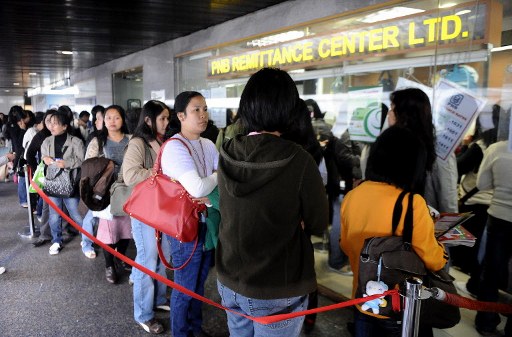Filipino workers sent home fewer dollars in November

Filipino domestic helpers line up to send money at a remittance center in the central district of Hong Kong. AFP PHOTO/TED ALJIBE/File photo
Personal remittances that Filipinos who are based abroad sent to the Philippines reached $2.93 billion in November, growing at the fastest pace of 5.8 percent in 17 months.
Despite this, the remittances in the 11th month of 2022 remained lower than the recent peak recorded in July of last year when the monthly inflow hit $3.24 billion.
Data from the Bangko Sentral ng Pilipinas (BSP) show that the previous peak in the monthly growth rate stood at 7.3 percent in June 2021.
The November readout brought personal remittances, which include transfers in kind, in January to November to $32.65 billion or 3.4 percent higher than the $31.59 billion that flowed in in the same period of 2021.
Land-based workers
The BSP said the continued growth of inflows was due to higher remittances sent by land-based workers with work contracts of one year or more, and by sea- and land-based workers with work contracts of less than one year.
Of the amount received in November, 90 percent represents cash that overseas Filipino workers (OFW) sent through banks. This was pegged at $2.64 billion, an increase of 5.7 percent from $2.5 billion in the same month in 2021.
Cash remittances for the January to November period tallied at $29.38 billion, an increase of 3.3 percent from $28.43 billion in the same 11 months of 2021.
The BSP said banks that are registered in the United States posted the highest share of Philippines-bound remittances, followed by those in Singapore and Saudi Arabia.
Currency weakness
Michael Ricafort, chief economist at Rizal Commercial Banking Corp., observed that cash remittances in November dropped to their lowest level in six month or since $2.4 billion in April 2022.
The November level was also 9.2 percent lower than the $2.91 billion recorded in the previous monthly, October 2022.
But Ricafort said it was still near the monthly record high of $2.987 billion that was seen 11 months earlier in December 2021.
“The slowdown in OFW remittances may have to do with the relatively higher US dollar-peso exchange rate compared to early 2022,” the economist said.
The Philippine peso ended trading in November at 56.56:$1, strengthening from 57.97:$1 at the end of October.
Ricafort said this partly led to a lower amount of US dollars sent by OFWs to the Philippines, given the higher equivalent of these remittances when converted to pesos.
“Furthermore, higher prices and inflation also in host countries of OFWs could have also increased the cost of living of OFWs abroad, thereby partly reducing the amount sent to the country,” he said. INQ
